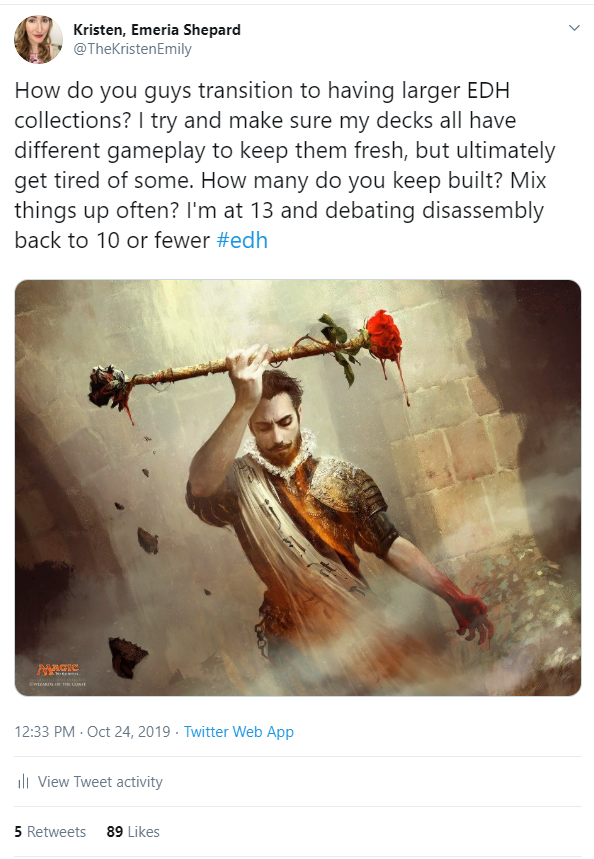Today on Legion’s Landing, Kristen looks into what keeps gameplay interesting and varied as a Commander collection grows. Variety is the spice of life, and that’s just what needs to be focused on, she argues.
Last week, I started a discussion on Twitter about how people keep things fresh when it comes to Commander. I love brewing decks, and so there’s always the chance I’ll be adding more decks to my collection with little persuasion. Once I hit on a deck I really like, I like to go one step further and get a suitable color sleeves and deckbox—one of the best things about Commander is the customization and personal angle, after all. Eventually though, the itch to brew outweighs the positives of keeping a deck built, and it’s re-absorbed into the card pool for future decks to draw from.
As the discussion evolved, it came clear that the average peak of unique decks that people had in rotation was between 10-12. The main reason people felt that limited them was lack of staples. The second reason, and the one I want to look at today, was that they felt it was hard to keep things fresh and unique.
Archetypal Challenges
The main reason for this is that there are only so many archetypes. Whilst you can have a lot of variety between, say, a Meren of Clan Nel Toth Aristocrats build and a Teysa Karlov Aristocrats build, ultimately the gameplay is what can make the experience a little too similar. Off the top of my head, the main archetypes for EDH tend to be: Aristocrats, Reanimator, Mill, Tribal, Stompy/Aggro, Voltron, Big-Mana Spells, Combo, Lands-matter, Artifacts, Stax, Hard Control, Group Hug/Slug, and Political. I almost certainly missed something there, but it does line up nicely with the 10-12 average that people reported keeping built in paper.
There are certainly themes that could add to the list, but they fit neatly into those archetypes. Lifegain, for instance, is generally either Aristocrats, Combo, Big-Mana Spells or Creature based aggro. Chaos fits somewhere between Group Hug/Slug and Political, and is altogether not for me, but you do you, Kya. 😉
Cultivating Your Collection
Most players will revisit decks in their collection as new sets come out; I struggle to recall a set coming out that didn’t have at least one card that I could get excited about adding to one of my decks. This is a great way to keep things innovative, and the bigger your lineup grows, the more inclined you’ll be to pre-order (sometimes multiple) singles that could make the cut. Often times, though, you’ll be adding cards that are merely more efficient versions of an existing card, and don’t do much to change how the deck plays.
I’d go one further than that, though, and suggest that adding cards to decks in this way often means you end up with more cards in common between decks than when you first drafted the deck. That’s not an issue, but it does lead to quicker homogenization in how decks tend to play out.
The more competitive and seasoned of you will be crying out that homogenization is merely the optimization of a deck, and that certain cards will always make the cut when trying to build decks to actually reliably win games. I don’t disagree, and I’ll be the first to admit that every deck I own runs Scavenger Grounds. Looking deeper into my non-Green decks, for example, you can see a clear alignment in certain cards: Burnished Hart, Sword of the Animist, Mask of Memory, Wayfarer’s Bauble, etc.
It’s true, especially of certain color decks, that a core of your deck will likely remain the same if you’re going for an optimized build. This is more true when building to a certain archetype over a certain theme. A good example of this is Reanimator style decks that feature Black and White—there are tried and tested “best” cards that any good deck wants; and the only thing that tends to draw you away from that is Tribal synergy, for instance running Bloodline Necromancer over more universal options in a Mardu Vampires build.
A good way to get around this is to keep cards distinct between decks—easier said than done for some color combinations, I know.
A Singleton Card Pool for a Singleton Format
The more extreme way of achieving this is to ensure that there are no shared cards between your decks. This works best for larger collections, and when not applied literally. Not running Cultivate in more than one deck is close to self-harm, after all.
A better way to apply this methodology is to make room for a certain quantity of “Straight to Commander” cards in your decks. You know exactly the kind of card I mean—the kind that people laugh over when reviewing a new set. Not constructed playable, but a fun and splashy card that does something new or unique. The way I approach this is to make sure I leave a couple of flex slots within my decks dedicated to these kinds of cards. It’s not going to cut it at cEDH levels, sure, but that’s not why you’re here.
If you can drop a staple without impacting the quality of your deck too much, consider doing so. Oracle of Mul Daya is a powerful card, but you don’t need it to win games, and usually eats removal anyway. Put in something new or spicy instead. The areas that are most flexible for this approach are your removal options and your creatures, so try experimenting with what can be thematic or take advantage of your decks mechanics—it’s cheaper than buying more copies of Damnation. The more staples that take slots in the shell of your deck, the more similar the decks will play out. There’s a reason “Good Stuff” is a deck theme, and there’s a reason it’s sometimes offered up reluctantly as being that theme—an embarrassment of riches is, believe it or not, embarrassing.
I’d be remiss to not mention the other option of saving money on extra copies, which is to sleeve decks in the same sleeves and swap cards in and out depending on what the decklist demands. It’s a great option when on a budget, but I usually prefer to play a different card if I can at all help it.
The Crux of the Matter
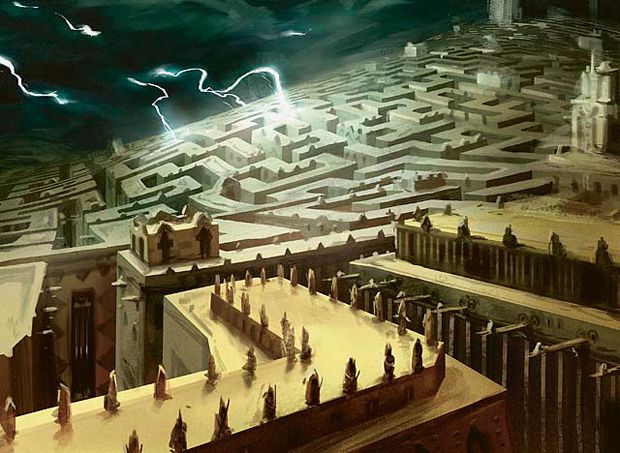
Card choices aside, what really limits the amount of fun and replay-ability you can squeeze from your decks is the gameplay itself. As previously mentioned, if the way the deck plays is similar to other decks in your collection, chances are it’ll sit on the sidelines and you’ll pick it up less often. Eventually, it might even drop off rotation altogether.
If you do have two decks that play similarly, it’s a good idea to try and mix up the minutia if you can. By this, I mean the way the deck ramps, draws cards, or removes creatures. These tend to be the most flexible slots, and can provide some different ways to play. A good example is choosing to use lifegain as a way to draw cards in an Orzhov/White deck, with cards like Well of Lost Dreams, Dawn of Hope, and Alhammarett’s Archive.
Leaning into lifegain can lead you down different routes, too, opening up token creation in cards like Resplendent Angel, or giving fuel for Aetherflux Reservoir as an alternate win condition. These slots could be taken up in another Orzhov deck by ways to sacrifice creatures to gain cards, for example. Changing the engine of a deck can do a lot to make it feel unique.
The other way is to give the deck a unique mechanic or interaction that you can lean into more heavily. For this, it’s a good time to showcase another one of my favorite decks: Rhonas the Indomitable.
Mixing Up Mono-Green Stompy
Green is perhaps the color that comes closest to having it all. Large, scary creatures, chunky bursts of card draw, incremental engine advantage, mana ramp, and the ability to still remove opposing creatures given the right cards—why wouldn’t you want to play it? Despite this, or more likely because of this, many Green decks can feel linear. Playing Cultivate on curve, dropping Oracle of Mul Daya and Seedborn Muse, and eventually ending with Avenger of Zendikar and Craterhoof Behemoth. These cards are heavily played because they’re excellent, but repeating the same game plan in multiple decks can reduce replay-ability and variety.
When I set out to build a Mono-Green deck for my roster of Commander decks, I had one goal in mind: create something fun, interactive and off the beaten track. Whilst I’m far from the only one to have built Rhonas the Indomitable, I am one of only 270 decks listed on EDHREC. Our reptilian God is all the way down at seventeenth-most popular Green Commander, and 308th overall.
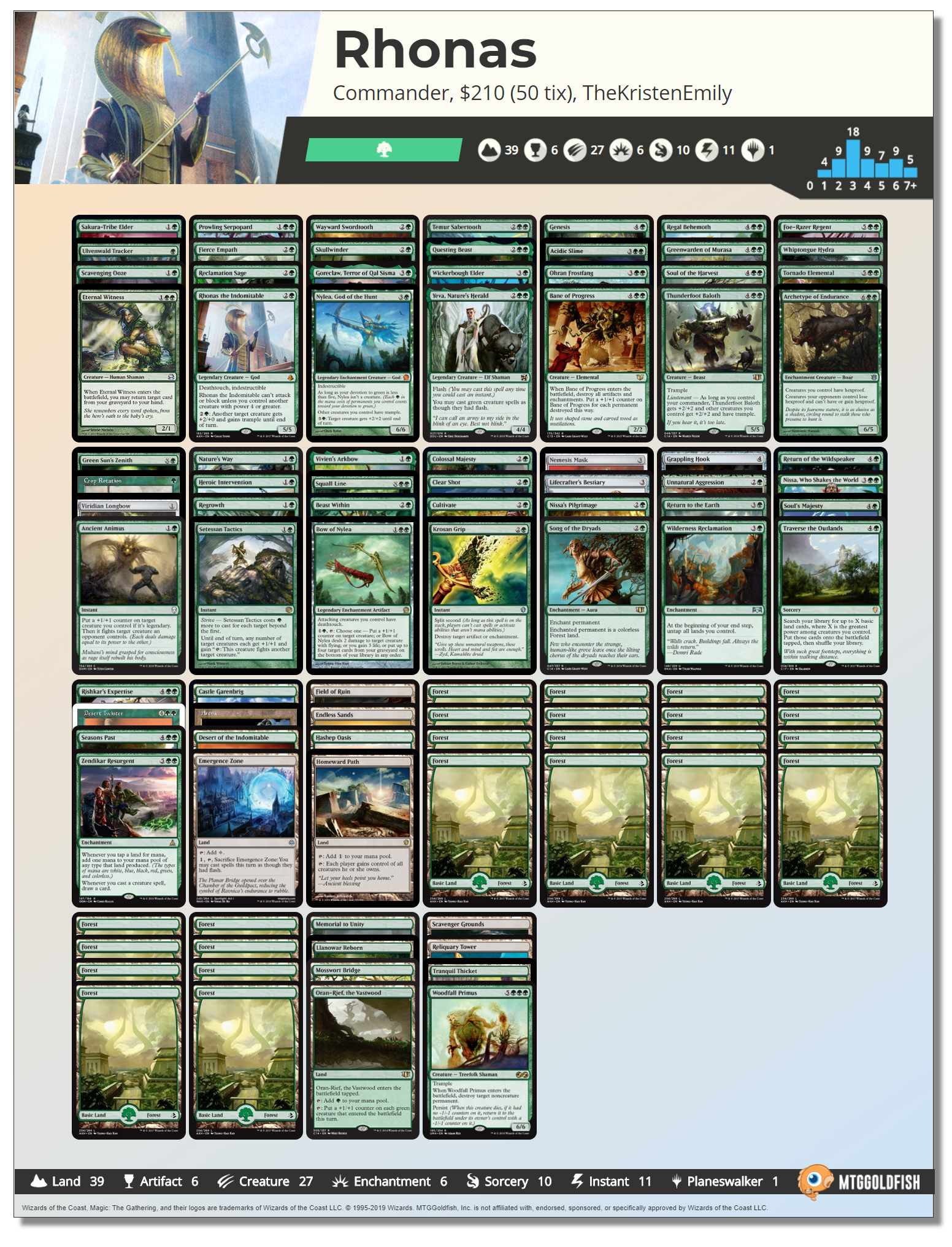
Despite still winning in the usual fashion a green-based creature deck tends to, the ways we get there offer a lot of fresh gameplay. Rhonas himself is a fantastic creature for three mana—sure, he won’t be attacking and winning games with Commander-damage very quickly, but his ability to win every fight he picks means we won’t have to worry about losing him.
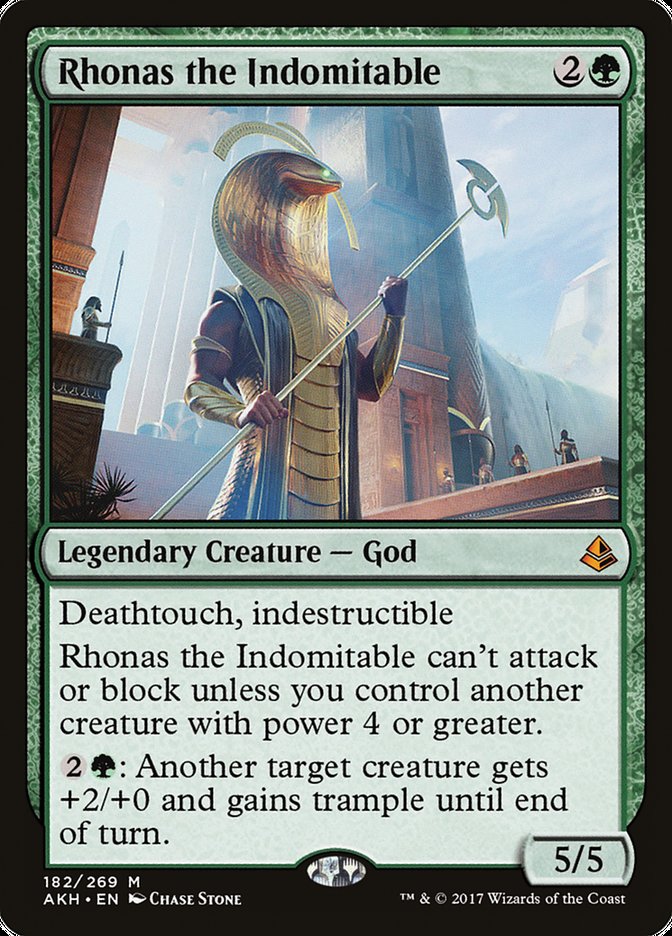
The deck runs a number of enablers, from fight spells like Unnatural Aggression (which even exiles!), “punch” effects like Nature’s Way, to repeatable effects like Viridian Longbow, which allows Rhonas to win Nylea’s favor with his dead-eye shooting. The deck even finds a home for Arena, a land more akin to a hard-to-interact-with-artifact. It doesn’t tap for mana, but lets us pay two mana every turn cycle to initiate single combat.
The fight mechanic is a lot of fun, and I’ll often make note of how high a “killstreak” I can reach in a game. Rhonas’s value as a deadly indestructible creature doesn’t end there, though. We run both Grappling Hook and Nemesis Mask—when Rhonas wants to rumble, he’s going in hard. Nemesis Mask in particular can often be a one-sided board wipe, and is a deadly tool in our arsenal.
To ensure Rhonas can actually attack and block, we focus on hitting the four power needed on another body, managing to fit in Prowling Serpopard at three mana and Yeva, Nature’s Herald at four. Only some of our utility creatures dip below that, with mainstays like Reclamation Sage and Eternal Witness. Wayward Swordtooth beats out cards like Azusa, Lost but Seeking due to the 5/5 statline at only three mana.
We also lean into deathtouch in order for our fight spells not to be redundant if Rhonas is not in play; running cards like Skullwinder for more recursion, Acidic Slime for more non-creature removal, and the brilliant Questing Beast from Throne of Eldraine for pure value.
One aspect of Rhonas is that he’s pretty hard to interact with. Outside of Swords to Plowshares, Path to Exile, and Reality Shift, most removal can’t hit him until later in the game. It’s a great chance to use cards like Traverse the Outlands, Soul’s Majesty, Rishkar’s Expertise, and the new Return of the Wildspeaker. We’re less likely to lose our creature in response to casting the spell, and five is a great number of lands to fetch or cards to draw. If the worst happens and somebody steals our Commander, the deck runs Homeward Path, with Crop Rotation to grab it. It’ll happen, and you’ll be outraged, so be prepared! If you thought he was hard to remove from the other side of the table, just try and do it with a Mono Green deck.
Flyers can be an issue for Green decks, so we have things covered with Whiptongue Hydra, the Bane of Progress for all things airborn (and we’re running Bane, too). We can also use Foe-Razer Regent to pick a fight and patrol the skies, Tornado Elemental, and Squall Line. I’ll get to both of those two in turn, as they’re great indicators of what else the deck has tried to do.
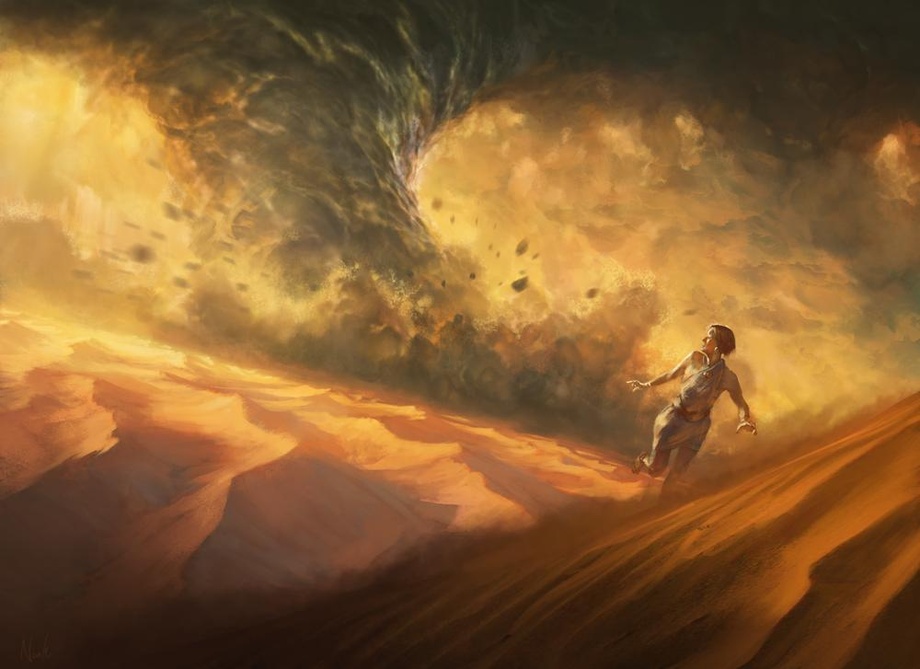
Desert Twister by Noah Bradley
In cards like Tornado Elemental and Desert Twister, I’ve tried to capture the Amonkhet flavor. This has gone as far as including matching Amonkhet full-art Basic Forests, lending the deck additional flavor. Imparting identity in this way is another underrated way to give a deck a unique feel, and one I’d definitely recommend.
Squall Line is an alternate win condition that I go into more detail in on my article about the importance of having one. Essentially, it allows you to take multiple players out at once, or really mess up blocking math for an opponent. Outside of Squall Line, we run Thunderfoot Baloth to allow the team to smash some face.
Overall, the deck is a lot of fun to play. I’ve obviously included a bunch of tried and tested Green cards that do a lot of work in the format, but I’ve tried to balance that out with some element of variety from a gameplay and flavor perspective.
In Conclusion
Repetitive gameplay is the deciding factor for dissolving a Commander deck, and it’s not something unique to the Commander format. Brian Braun-Duin has put up a great piece on why current Standard is lacking right now, and it touches on the fact that not having variety in gameplay is one of the main issues. It also goes over how Green has it all, and White is lacking identity—things we both know to be true, but for once not something I’m really going in deep on today.
As much as someone can enjoy a particular playstyle or theme, there is such a thing as too much of a good thing. I’ve just deconstructed a Geist of Saint Traft spirit tribal deck because it often leaned too far into a more Voltron strategy with certain hands—I already had a Voltron deck, and tribal decks, so really the deck wasn’t doing much for me.
If you find yourself getting bored of one of your decks, or lost as to what may give it some new life, consider changing things up with some of the idea discussed here today. Variety is the spice of life, after all, and with such a large card pool, our Commander decks should really reflect that more often. And who knows—you might just free up some staples for other decks.
Kristen is a lover of both Limited and Commander, and can most often be found championing the Boros Legion when called upon to sit down and shuffle up. Based in the UK, she works as a software developer, and her love for the Legion is second only to her appreciation for Lord of the Rings and Mass Effect.

